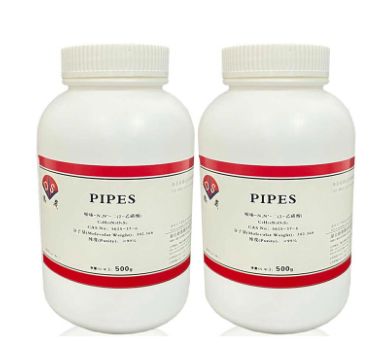PIPES buffer: an ideal choice for animal electron microscopy research
Release time:
2025-05-08
In animal electron microscopy research, sample preparation is one of the key steps determining imaging quality. In order to obtain high-resolution ultrastructural images, researchers need to use appropriate buffer solutions to fix and process tissue samples. PIPES buffer (piperazine-N, N '- di (2-ethylsulfonic acid)) has gradually become a popular choice in electron microscopy research as an organic buffer.

PIPES powder
The key to improving the details of ultrastructure
Research has shown that using PIPES as a buffer can significantly improve the quality of observed ultrastructural details under experimental conditions that require a longer period of fixed time. Compared with traditional inorganic buffers, PIPES can provide a more stable pH environment over a long period of time, which is particularly crucial for maintaining the integrity of cell structure. This means that scientists can study the complex structures inside cells in more detail, providing a solid foundation for understanding the mechanisms behind life processes.
The importance of avoiding interference from foreign ions
In addition to improving the details of ultrastructure, PIPES also has the important characteristic of not introducing foreign anions or cations into tissues. This property is particularly advantageous for energy dispersive X-ray analysis (EDX) as it allows for accurate elemental determination of thin slices of plastic embedded samples. By avoiding interference from foreign ions, researchers can obtain more accurate data, which is of great significance for further exploring the chemical composition of biomaterials.
Application Examples and Future Prospects
At present, PIPES has been widely applied in the study of various marine and mammalian tissues, and has shown better results than using some more common inorganic buffers. This not only promotes cutting-edge research in multiple fields such as biology, medicine, and materials science. With the continuous advancement of technology, we have reason to believe that PIPES will demonstrate its unique value in more unknown fields.
Advantages of PIPES buffer solution
Compared with traditional inorganic buffers such as phosphate buffer, PIPES buffer exhibits significant advantages in the following aspects:
1. Longer fixation time: PIPES buffer can better maintain the ultrastructure of tissues when prolonged fixation is required.
2. Higher imaging quality: Samples treated with PIPES buffer have higher contrast and resolution in their electron microscope images.
3. Less interference: PIPES buffer does not introduce foreign ions, ensuring the accuracy of subsequent analysis.

Product packaging
In electron microscopy research, high-quality biological buffering agents are key to obtaining reliable results. As a company dedicated to the research and production of high-performance chemical reagents, our PIPES buffer solution has won the trust of a large number of researchers with its excellent performance and stable quality. Desheng New Materials will continue to devote itself to the research and development of biological buffering agents, providing solid support for scientific research. Choosing Desheng New Materials is choosing a solid foundation for science, let's work together to create a better future for life sciences.
Contact details
Contact number
Address: C8, Guanggu United Science and Technology City, Ezhou City, Hubei Province
Fax:0711-3704 589
Follow us



